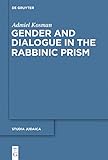Gender and Dialogue in the Rabbinic Prism / Admiel Kosman.
Material type: TextSeries: Studia Judaica : Forschungen zur Wissenschaft des Judentums ; 50Publisher: Berlin ; Boston : De Gruyter, [2012]Copyright date: ©2012Description: 1 online resource (268 p.)Content type:
TextSeries: Studia Judaica : Forschungen zur Wissenschaft des Judentums ; 50Publisher: Berlin ; Boston : De Gruyter, [2012]Copyright date: ©2012Description: 1 online resource (268 p.)Content type: - 9783110207057
- 9783110218640
- Jewish philosophy
- Judaism and psychoanalysis
- Man-woman relationships
- Masculinity -- Religious aspects -- Judaism
- Psychoanalysis and religion
- Women in rabbinical literature
- Aggadah (Talmud)
- Gender
- Jüdische Spiritualität
- Psychoanalyse
- RELIGION / Judaism / Talmud
- Close Reading
- Gender
- Jewish Spirituality
- Psychoanalysis
- Talmudic Aggadah
- 296.1206082 22/ger
- BM509.W7 K66 2012
- online - DeGruyter
- Issued also in print.
| Item type | Current library | Call number | URL | Status | Notes | Barcode | |
|---|---|---|---|---|---|---|---|
 eBook
eBook
|
Biblioteca "Angelicum" Pont. Univ. S.Tommaso d'Aquino Nuvola online | online - DeGruyter (Browse shelf(Opens below)) | Online access | Not for loan (Accesso limitato) | Accesso per gli utenti autorizzati / Access for authorized users | (dgr)9783110218640 |
Browsing Biblioteca "Angelicum" Pont. Univ. S.Tommaso d'Aquino shelves, Shelving location: Nuvola online Close shelf browser (Hides shelf browser)

|

|

|

|

|

|

|
||
| online - DeGruyter Strength Relations in Phonology / | online - DeGruyter Von Arius zum Athanasianum : Studien zur Edition der "Athanasius Werke" / | online - DeGruyter Theodor von Mopsuestia, De incarnatione : Überlieferung und Christologie der griechischen und lateinischen Fragmente einschließlich Textausgabe / | online - DeGruyter Gender and Dialogue in the Rabbinic Prism / | online - DeGruyter Understanding Religion : Selected Essays / | online - DeGruyter I Progimnasmi di Severo di Alessandria (Severo di Antiochia?) : Introduzione, traduzione e commento / | online - DeGruyter Analecta Septentrionalia : Beiträge zur nordgermanischen Kultur- und Literaturgeschichte / |
Frontmatter -- Contents -- In Place of an Introduction: On Gender Issues and Their Possible Significance for Understanding the Spiritual World of the Rabbis -- Chapter One. The Woman’s Spiritual Place in the Talmudic Story: A Reading of the Narrative of Mar Ukba and His Wife -- Chapter Two. Rabbi Akiva and the Daughter of Ben Kalba Savua: On the Conception of Love in the Spiritual World of the Talmudic Story -- Chapter 3. “Internal Homeland” and “External Homeland”: A Literary and Psychoanalytical Study of the Narrative of R. Assi and His Aged Mother -- Chapter 4. The Female Breast and the Mouth Opened in Prayer -- Chapter Five. A Reading of the Creation Narrative: Femininity and Masculinity in the Prism of the Bible and the Midrash -- Afterword -- Bibliography -- Index -- Index of Sources
restricted access online access with authorization star
http://purl.org/coar/access_right/c_16ec
The author applies the fields of gender studies, psychoanalysis, and literature to Talmudic texts. In opposition to the perception of Judaism as a legal system, he argues that the Talmud demands inner spiritual effort, to which the trait of humility and the refinement of the ego are central. This leads to the question of the attitude to the Other, in general, and especially to women. The author shows that the Talmud places the woman (who represents humility and good-heartedness in the Talmudic narratives) above the character of the male depicted in these narratives as a scholar with an inflated sense of self-importance.In the last chapter (that in terms of its scope and content could be a freestanding monograph) the author employs the insights that emerged from the preceding chapters to present a new reading of the Creation narrative in the Bible and the Rabbinic commentaries. The divine act of creation is presented as a primal sexual act, a sort of dialogic model of the consummate sanctity that takes its place in man’s spiritual life when the option of opening one’s heart to the other in a male-female dialogue is realized.
Issued also in print.
Mode of access: Internet via World Wide Web.
In English.
Description based on online resource; title from PDF title page (publisher's Web site, viewed 28. Feb 2023)


